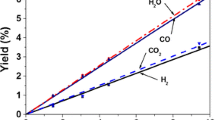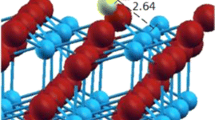Abstract
The effect of oxygen vacancies on the adsorption and activation of CO2 on the surface of different phases of ZrO2 is investigated by density functional theory (DFT) calculations. The calculations show that the oxygen vacancies contribute greatly to both the adsorption and activation of CO2. The adsorption energy of CO2 on the c-ZrO2, t-ZrO2 and, m-ZrO2 surfaces is enhanced to 5, 4, and 3 folds with the help of oxygen vacancies, respectively. Moreover, the energy barrier of CO2 dissociation on the defective surfaces of c-ZrO2, t-ZrO2, and m-ZrO2 is reduced to 1/2, 1/4, and 1/5 of the perfect surface with the assistance of oxygen vacancies. Furthermore, the activation of CO2 on the ZrO2 surface where oxygen vacancies are present, and changes from an endothermic reaction to an exothermic reaction. This finding demonstrates that the presence of oxygen vacancies promotes the activation of CO2 both kinetically and thermodynamically. These results could provide guidance for the high-efficient utilization of CO2 at an atomic scale.
Similar content being viewed by others
References
Tollefson J. World looks ahead post-Copenhagen. Nature, 2009, 462(7276): 966–967
Tollefson J. Copenhagen: The scientists’ view. Nature, 2009, 462(7274): 714–715
Wang W, Wang S, Ma X, et al. Recent advances in catalytic hydrogenation of carbon dioxide. Chemical Society Reviews, 2011, 40(7): 3703–3727
Valluri S, Claremboux V, Kawatra S. Opportunities and challenges in CO2 utilization. Journal of Environmental Sciences (China), 2022, 113(3): 322–344
Wang X, Pan C, Romero C E, et al. Thermo-economic analysis of a direct supercritical CO2 electric power generation system using geothermal heat. Frontiers in Energy, 2022, 16(2): 246–262
Wang H, He J. China’s pre-2020 CO2 emission reduction potential and its influence. Frontiers in Energy, 2019, 13(3): 571–578
Honda M, Tamura M, Nakagawa Y, et al. Ceria-catalyzed conversion of carbon dioxide into dimethyl carbonate with 2-cyanopyridine. ChemSusChem, 2013, 6(8): 1341–1344
Díez-Ramírez J, Díaz J A, Sánchez P, et al. Optimization of the Pd/Cu ratio in Pd-Cu-Zn/SiC catalysts for the CO2 hydrogenation to methanol at atmospheric pressure. Journal of CO2 Utilization, 2017, 22: 71–80
Frei M S, Mondelli C, Cesarini A, et al. Role of zirconia in indium oxide-catalyzed CO2 hydrogenation to methanol. ACS Catalysis, 2020, 10(2): 1133–1145
Temvuttirojn C, Poo-arporn Y, Chanlek N, et al. Role of calcination temperatures of ZrO2 support on methanol synthesis from CO2 hydrogenation at high reaction temperatures over ZnOx/ZrO2 catalysts. Industrial & Engineering Chemistry Research, 2020, 59(13): 5525–5535
Numpilai T, Kidkhunthod P, Cheng C K, et al. CO2 hydrogenation to methanol at high reaction temperatures over In2O3/ZrO2 catalysts: Influence of calcination temperatures of ZrO2 support. Catalysis Today, 2021, 375: 298–306
Witoon T, Chalorngtham J, Dumrongbunditkul P, et al. CO2 hydrogenation to methanol over Cu/ZrO2 catalysts: effects of zirconia phases. Chemical Engineering Journal, 2016, 293: 327–336
Witoon T, Numpilai T, Nijpanich S, et al. Enhanced CO2 hydrogenation to higher alcohols over K-Co promoted In2O3 catalysts. Chemical Engineering Journal, 2022, 431: 133211
Witoon T, Lapkeatseree V, Numpilai T, et al. CO2 hydrogenation to light olefins over mixed Fe-Co-K-Al oxides catalysts prepared via precipitation and reduction methods. Chemical Engineering Journal, 2022, 428: 131389
Stroud T, Smith T J, Le Saché E, et al. Chemical CO2 recycling via dry and bi reforming of methane using Ni-Sn/Al2O3 and Ni-Sn/CeO2-Al2O3 catalysts. Applied Catalysis B: Environmental, 2018, 224: 125–135
Rubin E S, Cooper R N, Frosch R A, et al. Realistic mitigation options for global warming. Science, 1992, 257(5067): 148–266
Anderson R B. Fischer-Tropsch Synthesis. New York: Academic Press, 1984
Schulz H. Short history and present trends of Fischer-Tropsch synthesis. Applied Catalysis A: General, 1999, 186(1–2): 3–12
Zhang C, Li Y, He Z, et al. Microtubular Fe/Mn-promoted CaO-Ca12Al14O33 bi-functional material for H2 production from sorption enhanced water gas shift. Applied Catalysis B: Environmental, 2022, 314: 121474
Van de Loosdrecht J, Botes F G, Ciobica I M, et al. Fischer-Tropsch synthesis: Catalysts and chemistry. In: Reedijk J, Poeppelmeier K, eds. Comprehensive Inorganic Chemistry II: From Elements to Applications. Elsevier, 2013: 525–557
Chen Y, Wei J, Duyar M S, et al. Carbon-based catalysts for Fischer-Tropsch synthesis. Chemical Society Reviews, 2021, 50(4): 2337–2366
Ashrafi M, Pröll T, Pfeifer C, et al. Experimental study of model biogas catalytic steam reforming: 1. Thermodynamic optimization. Energy & Fuels, 2008, 22(6): 4182–4189
Xu Y, Lausche A C, Wang S, et al. In silico search for novel methane steam reforming catalysts. New Journal of Physics, 2013, 15(12): 125021
Fattahi A, McCarthy R E, Ahmad M R, et al. Why does cyclopropene have the acidity of an acetylene but the bond energy of methane? Journal of the American Chemical Society, 2003, 125(38): 11746–11750
Lv J, Wang D, Wei B, et al. Integrated process of coal pyrolysis with dry reforming of low carbon alkane over Ni/La2O3-ZrO2 with different La/Zr ratio. Fuel, 2021, 292: 120412
Fakeeha A H, Kurdi A, Al-Baqmaa Y A, et al. Performance study of methane dry reforming on Ni/ZrO2 catalyst. Energies, 2022, 15(10): 3841
Lu Y, Guo D, Zhao Y, et al. Enhanced catalytic performance of Nix-V@HSS catalysts for the DRM reaction: The study of interfacial effects on Ni-VOx structure with a unique yolk-shell structure. Journal of Catalysis, 2021, 396: 65–80
Qin Z, Chen L, Chen J, et al. Ni/CeO2 prepared by improved polyol method for DRM with highly dispersed Ni. Greenhouse Gases. Science and Technology, 2021, 11(6): 1245–1264
Gao X, Lin Z, Li T, et al. Recent developments in dielectric barrier discharge plasma-assisted catalytic dry reforming of methane over Ni-based catalysts. Catalysts, 2021, 11(4): 455
Zhang L, Meng Y, Yang J, et al. Theoretical study on dry reforming of methane catalyzed by Cu12M (M= Cu, Fe, Co, Ni) core-shell bimetallic clusters. Fuel, 2021, 303: 121263
Qiu H, Ran J, Niu J, et al. Effect of different doping ratios of Cu on the carbon formation and the elimination on Ni(111) surface: A DFT study. Molecular Catalysis, 2021, 502: 111360
Ou Z, Ran J, Qiu H, et al. Uncovering the effect of surface basicity on the carbon deposition of Ni/CeO2 catalyst modified by oxides in DRM. Fuel, 2023, 335: 126994
Hao S, Zhang H. High catalytic performance of nitrate reduction by synergistic effect of zero-valent iron (FeO) and bimetallic composite carrier catalyst. Journal of Cleaner Production, 2017, 167: 192–200
Yang W, Zhao H, Wang K, et al. Synergistic effects of mixtures of iron ores and copper ores as oxygen carriers in chemical-looping combustion. Proceedings of the Combustion Institute, 2015, 35(3): 2811–2818
Nagappagari L R, Samanta S, Sharma N, et al. Synergistic effect of a noble metal free Ni(OH)2 co-catalyst and a ternary ZnIn2S4/g-C3N4 heterojunction for enhanced visible light photocatalytic hydrogen evolution. Sustainable Energy & Fuels, 2020, 4(2): 750–759
Chen H Y T, Tosoni S, Pacchioni G. A DFT study of the acid-base properties of anatase TiO2 and tetragonal ZrO2 by adsorption of CO and CO2 probe molecules. Surface Science, 2016, 652: 163–171
Liang Z, Wang W, Zhang M, et al. Structural, mechanical and thermodynamic properties of ZrO2 polymorphs by first-principles calculation. Physica B, Condensed Matter, 2017, 511: 10–19
Murota T, Hasegawa T, Aozasa S, et al. Production method of cerium oxide with high storage capacity of oxygen and its mechanism. Journal of Alloys and Compounds, 1993, 193(1–2): 298–299
Chen C, Ruan C, Zhan Y, et al. The significant role of oxygen vacancy in Cu/ZrO2 catalyst for enhancing water—gas-shift performance. International Journal of Hydrogen Energy, 2014, 39(1): 317–324
Han X, Yang J, Han B, et al. Density functional theory study of the mechanism of CO methanation on Ni4/t-ZrO2 catalysts: Roles of surface oxygen vacancies and hydroxyl groups. International Journal of Hydrogen Energy, 2017, 42(1): 177–192
Petchmark M, Ruangpornvisuti V. Hydrogen adsorption on c-ZrO2(111), t-ZrO2(101), and m-ZrO2(111) surfaces and their oxygen-vacancy defect for hydrogen sensing and storage: A first-principles investigation. Materials Letters, 2021, 301: 130243
Alioui O, Badawi M, Erto A, et al. Contribution of DFT to the optimization of Ni-based catalysts for dry reforming of methane: A review. Catalysis Reviews-Science and Engineering, 2022, online, https://doi.org/10.1080/01614940.2021.2020518
Zhu Z, Tao H, Zhou Y. Using density functional theory to unravel the size-dependent effect of Au nanoparticles and au single atoms adsorbed on carbon nitride for the hydrogenation of nitrobenzene. ACS Applied Nano Materials, 2022, 5(12): 18753–18760
Niu J, Chen S, Zheng X, et al. Understanding the effect of Ni cluster size on methane activation and dehydrogenation. International Journal of Hydrogen Energy, 2022, online, https://doi.org/10.1016/j.ijhydene.2022.12.174
Fakeeha A H, Kurdi A, Al-Baqmaa Y A, et al. Performance study of methane dry reforming on Ni/ZrO2 catalyst. Energies, 2022, 15(10): 3841
Hu X, Jia X, Zhang X, et al. Improvement in the activity of Ni/ZrO2 by cold plasma decomposition for dry reforming of methane. Catalysis Communications, 2019, 128: 105720
Niu J, Liu H, Jin Y, et al. Comprehensive review of Cu-based CO2 hydrogenation to CH3OH: Insights from experimental work and theoretical analysis. International Journal of Hydrogen Energy, 2022, 47(15): 9183–9200
Niu J, Liu H, Jin Y, et al. A density functional theory study of methane activation on MgO supported Ni9M1 cluster: Role of M on C-H activation. Frontiers of Chemical Science and Engineering, 2022, 16(10): 1485–1492
Han L, Jing F, Zhang J, et al. Environment friendly and remarkably efficient photocatalytic hydrogen evolution based on metal organic framework derived hexagonal/cubic In2O3 phase-junction. Applied Catalysis B: Environmental, 2021, 282: 119602
Chen J, Abazari R, Adegoke K A, et al. Metal—organic frameworks and derived materials as photocatalysts for water splitting and carbon dioxide reduction. Coordination Chemistry Reviews, 2022, 469: 214664
Delley B. An all-electron numerical method for solving the local density functional for polyatomic molecules. Journal of Chemical Physics, 1990, 92(1): 508–517
Delley B. From molecules to solids with the DMol3 approach. Journal of Chemical Physics, 2000, 113(18): 7756–7764
Perdew J P, Burke K, Ernzerhof M. Generalized gradient approximation made simple. Physical Review Letters, 1996, 77(18): 3865–3868
Gerald K. X-Ray diffraction powder pattern of metastable cubic ZrO2. Journal of the American Ceramic Society, 1971, 54(10): 531–531
Toraya H, Yoshimura M, Somiya S. Calibration curve for quantitative analysis of the monoclinic-tetragonal ZrO2 system by X-ray diffraction. Journal of the American Ceramic Society, 1984, 67(6): 119–121
Christensen A, Carter E A. First-principles study of the surfaces of zirconia. Physical Review B: Condensed Matter, 1998, 58(12): 8050–8064
Arce-Ramos J M, Grabow L C, Handy B E, et al. Nature of acid sites in silica-supported zirconium oxide: a combined experimental and periodic DFT study. Journal of Physical Chemistry C, 2015, 119(27): 15150–15159
Taoudi A, Laval J P, Frit B. Synthesis and crystal structure of three new rare earth oxyfluorides related to baddeleyite [LnOF; Ln= Tm, Yb, Lu]. Materials Research Bulletin, 1994, 29(11): 1137–1147
Steib M, Lou Y, Jentys A, et al. Enhanced activity in methane dry reforming by carbon dioxide induced metal-oxide interface restructuring of nickel/zirconia. ChemCatChem, 2017, 9(20): 3809–3813
Acknowledgements
This work was supported by the National Natural Science Foundation of China (Grant No. 52106179) and the Fundamental Research Program of Shanxi Province, China (Grant No. 20210302124017).
Author information
Authors and Affiliations
Corresponding author
Ethics declarations
Competing interests The authors declare that they have no competing interests.
Rights and permissions
About this article
Cite this article
Niu, J., Zhang, C., Liu, H. et al. Enhanced performance of oxygen vacancies on CO2 adsorption and activation over different phases of ZrO2. Front. Energy 17, 545–554 (2023). https://doi.org/10.1007/s11708-023-0867-7
Received:
Accepted:
Published:
Issue Date:
DOI: https://doi.org/10.1007/s11708-023-0867-7




